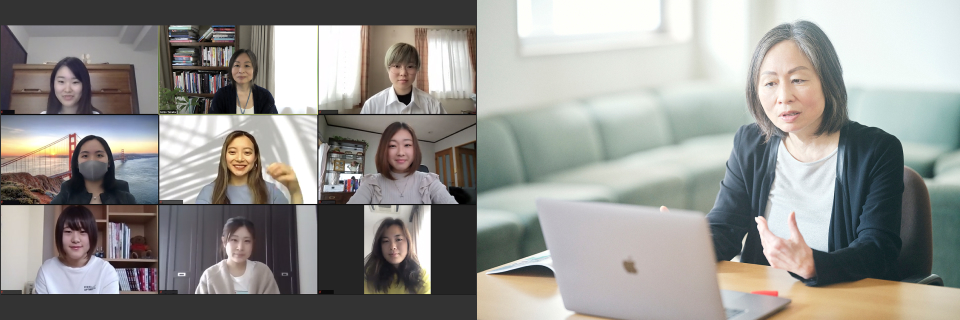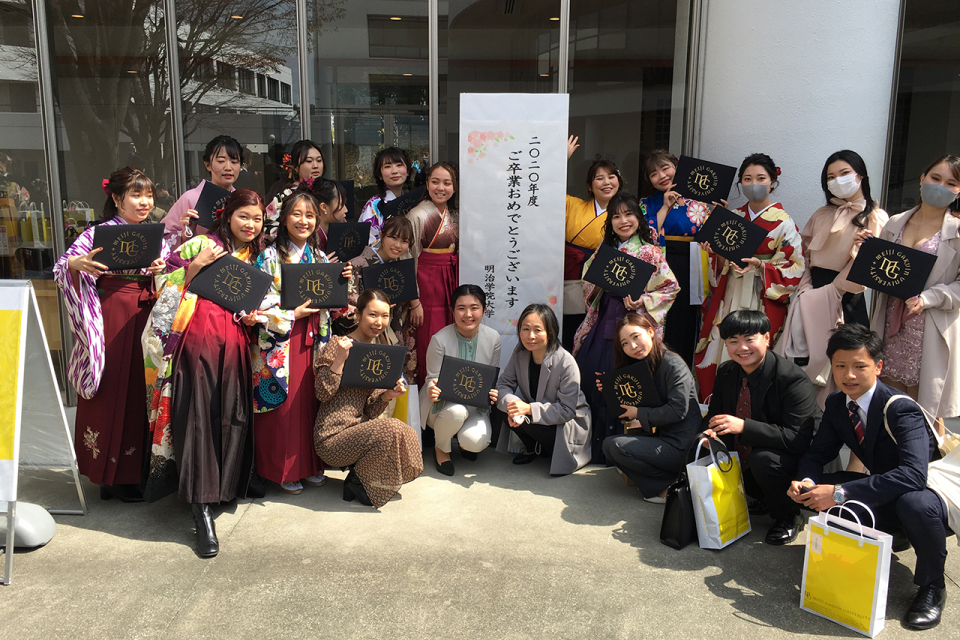Words have a heart: Developing English capabilities for intercultural communication
The 2020 academic year saw English education in Japan transition into the government’s new curriculum guidelines, which stipulated that formal English instruction would begin in the third year of elementary school. The English portions of university-entrance examinations also underwent changes as the country implemented the Common Test for University Admissions. To Professor Keiko Tanaka, however, English education in Japan still has a long way to go. From her perspective as a scholar and former instructor at an American university who was also involved in the creation of the Global & Transcultural Studies Department in the Faculty of International Studies at Meiji Gakuin University, Tanaka says that “Japan’s approach to English education isn’t adequate for learners in a twenty-first-century context.” Read on to find out how Tanaka envisions the ideal English education and the multicultural society that learning English as a lingua franca can pave the way for.


Keiko Tanaka
Professor, Department of International Studies, Faculty of International Studies
The holder of a PhD in education from the University of California, Berkeley, Tanaka specializes in second language acquisition and bilingualism; linguistics, sociolinguistics, and applied linguistics; language program administration and policy in higher education; and the theory and practice of language education. She grew up in international environments, living in several different countries, and later worked professionally abroad as an instructor at institutions like the Monterey Institute of International Studies (US) and California State University before eventually returning to Japan. At Meiji Gakuin University, Tanaka has served as the Department Chair of International Studies in the Faculty of International Studies (AY2015–16) and the director of the International Center (AY2018–19). She is now the co-leader of a new university project that at once offers courses cooperatively with overseas universities and organizations and promotes international exchange via online and virtual methods.
-
Aim for “English for all,” not perfect English
Following the Meiji Restoration, Japanese schools started pouring their resources into training students who are competent in English to help the country import as much knowledge as it could from its more advanced Western counterparts. That traditional approach to English education in Japan is now at a crossroads—or, the way I see it, significantly overdue for sweeping changes.
Unlike many parts of the world, Japan is far from being a multilingual-multicultural society, which is maybe why it tends to be quite conservative about education in the language sphere—and that goes for foreign language education and Japanese-language education alike. Take the issue of the “dropped ra” syllable phenomenon prevalent among Japanese youth, for example. The ra is a standard addition to Japanese verbs in their potential form, but younger generation often omits the syllable. Dropping the ra might technically be “wrong” in today’s Japanese pedagogy. Older people most likely find the phrasing unnatural or improper. The thing is, however, that the words that sound “natural” to Japanese people now are likely to sound impolite or even incomprehensible to people in the E do period, the Meiji period, the Taisho period, and even the Showa period, when the parents of today’s college students were born. Languages are alive; it only makes natural sense that they evolve over time. I like to cover these themes in my applied linguistics course, which goes into language variation, changes in language, and other dynamics like the connections between language and gender.

Japan is facing a demographic crisis on a level that largely defies comparison. With the population aging and the birthrate falling, the number of native Japanese speakers will soon embark on a steady decline. Once the world emerges from the COVID-19 pandemic, Japan will see a growing influx of foreign nationals, and the numbers of marriages between Japanese people and foreign partners is sure to rise. Like it or not, Japan is on the path toward becoming a multilingual society.What kind of English education will we need to adapt to those shifting dynamics? I’m almost positive that it will not be the old style of students frantically memorizing intricate rules and patterns to ace grammar tests. When I was working on my doctorate in the United States, I met plenty of students from around the world. Everyone I met was proficient in at least two languages, but no one spoke “perfect” English. What people need to get by in a multilingual milieu isn’t necessarily native-level command of one language or another—it’s the smarts and the will to use all the linguistic resources and communicative strategies available that enables communication with the world.
Some language-education experts argue that Japanese people should start learning English after mastering Japanese. In the global society of the twenty-first century, though, that kind of stance is just a recipe for putting learners behind. Making perfection in one language a prerequisite for learning a new language—not to mention aiming for perfection in the new language—is more of a detriment to learning than an enabler, I think. The most crucial factor in global communication isn’t a flawless command of English. It’s the deeper desire to know about a world outside your own, a curiosity about others. The key is communicating from the heart.
Creating an environment where students don’t just “learn English” but also “learn in English”
I’m a linguist, but my main focus is educational linguistics. As such, I helped develop the language-education curriculum for the Faculty of International Studies at Meiji Gakuin.
From my perspective, Japan should work to incorporate immersion-style bilingual education into its new approach to English education—and make it a part of the curriculum at as early a stage as possible. Immersion means submerging or soaking something in something else, the way you soak vegetables in water. If you start “immersing” elementary school children in an environment where English (or another foreign language) is the language of communication, they can learn both the language itself and other courses—science, social studies, or anything else—in that new language, too, making for a richer, more effective learning experience.

Meiji Gakuin launched a new project in the fall of AY2020 to develop and introduce educational materials and a curriculum for twenty-first-century liberal arts education in an effort to help cultivate global citizens. Working with foreign universities and international organizations, the project is aiming to formulate an interdisciplinary curriculum that enables students to grow as global citizens, develop their proficiency in English as a global communication tool, and learn in a liberal-arts framework with international counterparts via the internet and other technologies. In the fall of AY2020, amid the COVID-19 crisis, the project started holding joint courses online with the University of Hawai’i at Mānoa. The project went over extremely well with the Japanese participants, who said that studying abroad virtually helped them “gain much-needed confidence using English,” “broaden academic horizons,” and “meet friendly students from the United States for a fun, rewarding learning experience.”Prominent universities overseas develop and organize these kinds of internet-based international education programs with other foreign institutions as Collaborative Online International Learning (COIL) projects. At Meiji Gakuin, too, we look forward to pursuing COIL-type efforts to give students better environments for learning English—which is at the moment, a global language—and reap the benefits of international education.
Imagining a multicultural future with students from a diversity of backgrounds
Let me stop here and explain a little bit of my own personal story. When I was still in my first years of elementary school, my family packed up and moved to Hong Kong for my dad’s job. I remember how hard and frustrating it all was, especially not knowing the language or the culture. I hated it so much, apparently, that I even told my parents to put me in a suitcase and ship me back to Japan. I found myself in the same situations wherever we ended up moving, from Europe to the United States, but the frustration eventually turned into motivation: I wanted to understand the different cultures and learn English instead of shutting it all out. I started seeing the experience as a blessing, not a curse, an opportunity to be a bridge between Japan and the world. That’s where my career as an educator and a scholar got its start.
After I got my bachelor’s degree in Japan, I enrolled in a graduate program at the University of California, Berkeley. I eventually got my PhD with a concentration in language, literacy, and culture and decided to stay in the United States, taking a faculty position in the Department of English Literature and Language at California State University. I stayed because I wanted to help narrow the gaps in American society through education, and I joined a group of other faculty members working to provide educational opportunities to minority and immigrant students from around the world. Everything I saw, heard, and learned through that experience plays into my teaching at Meiji Gakuin.

My seminar, which centers on the themes of globalization and multiculturalism, delves into how various governmental policies, educational efforts, and community-level projects are addressing the issue of multicultural coexistence both in Japan and around the world. For one reason or another, the seminar tends to draw a lot of students with roots in other Asian countries, Africa, and Latin America. With all that diversity in the classroom, the discussions we have are lively exchanges that go back and forth between English and Japanese.To live better, richer lives in the Japan’s dawning multicultural society, students will need to acquire sensitivity and skills to recognize discriminatory attitudes and behaviors against minorities and the socially vulnerable, as well as stereotypical conceptions of gender, as immediate issues and act accordingly. I want my seminars and classes to be collaborative platforms for cultivating that sensitivity, environments where we can think together about how to foster multiculturalism, encourage each other to take steps forward, and get the support we need to thrive and grow as individuals in an ever-changing world.
The key to a multicultural society is simple. It all comes down to the “Do for Others” concept at the heart of Meiji Gakuin’s educational philosophy, a crystallization of the Golden Rule: do unto others as you would have them done unto you.

Ever since I moved to Hong Kong as a little girl, I’ve always been aware of—and taken exception to—racial discrimination, gender discrimination, and other forms of “othering.” I think I’ve taken steps to act on that stance, too. Now, though, it might be time for me to pass that torch on to my students and the rest of the next generation. The ultimate goal, for me, is to make sure that true multicultural coexistence—a reality where people of all kinds are free to pursue happiness of all kinds in a spirit of mutuality and equality—can take root. Moving forward, I will do everything I can to shape Meiji Gakuin’s framework for English education and international education around that vision.
